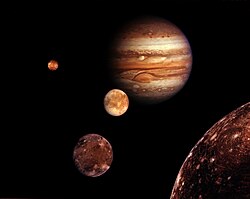 Discovery image of Desdemona | |
| Discovery | |
|---|---|
| Discovered by | Stephen P. Synnott / Voyager 2 |
| Discovery date | January 13, 1986 |
| Designations | |
Designation | Uranus X |
| Pronunciation | /dɛzdəˈmoʊnə/ [1] |
| Adjectives | Desdemonan, [2] Desdemonian, [3] Desdemonean [4] /dɛzdəˈmoʊn(i)ən/ |
| Orbital characteristics [5] | |
| 62,658.364 ± 0.047 km | |
| Eccentricity | 0.00013 ± 0.000070 |
| 0.473649597 ± 0.000000014 d | |
| Inclination | 0.11252 ± 0.037° (to Uranus's equator) |
| Satellite of | Uranus |
| Physical characteristics | |
| Dimensions | 90 × 54 × 54 km [6] [note 1] |
| ~13,000 km2 [a] | |
| Volume | 137400 km3 ± 37.5% [7] |
| Mass | (1.237±0.436)×1017 kg [7] |
Mean density | 0.5–1.2 g/cm3 [8] 0.90 g/cm3 (assumed) [7] |
| synchronous [6] | |
| zero [6] | |
| Albedo | 0.08 ± 0.01 [9] 0.07 [10] [11] |
| |
Desdemona is an inner satellite of Uranus. It was discovered from the images taken by Voyager 2 on 13 January 1986, and was given the temporary designation S/1986 U 6. [12] Desdemona is named after the wife of Othello in William Shakespeare's play Othello . It is also designated Uranus X. [13]
Contents
Desdemona belongs to the Portia group of satellites, which also includes Bianca, Cressida, Juliet, Portia, Rosalind, Cupid, Belinda, and Perdita. [9] These satellites have similar orbits and photometric properties. [9] Other than its orbit, [5] size of 90 km × 54 km (56 mi × 34 mi), [6] and geometric albedo of 0.08, [9] little is known about Desdemona.
In Voyager 2 imagery, Desdemona appears as an elongated object, with its major axis pointing towards Uranus. The ratio of axes of Desdemona's prolate spheroid is 0.6 ± 0.3. [6] Its surface is grey in color. [6]
Desdemona may collide with one of its neighboring moons Cressida or Juliet within the next 100 million years. [14]

